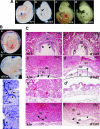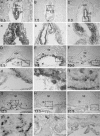Transcriptional repressor erf determines extraembryonic ectoderm differentiation
- PMID: 17502352
- PMCID: PMC1951951
- DOI: 10.1128/MCB.02237-06
Transcriptional repressor erf determines extraembryonic ectoderm differentiation
Abstract
Extraembryonic ectoderm differentiation and chorioallantoic attachment are fibroblast growth factor (FGF)- and transforming growth factor beta-regulated processes that are the first steps in the development of the placenta labyrinth and the establishment of the fetal-maternal circulation in the developing embryo. Only a small number of genes have been demonstrated to be important in trophoblast stem cell differentiation. Erf is a ubiquitously expressed Erk-regulated, ets domain transcriptional repressor expressed throughout embryonic development and adulthood. However, in the developing placenta, after 7.5 days postcoitum (dpc) its expression is restricted to the extraembryonic ectoderm, and its expression is restricted after 9.5 dpc in a subpopulation of labyrinth cells. Homozygous deletion of Erf in mice leads to a block of chorionic cell differentiation before chorioallantoic attachment, resulting in a persisting chorion layer, a persisting ectoplacental cone cavity, failure of chorioallantoic attachment, and absence of labyrinth. These defects result in embryo death by 10.5 dpc. Trophoblast stem cell lines derived from Erf(dl1/dl1) knockout blastocysts exhibit delayed differentiation and decreased expression of spongiotrophoblast markers, consistent with the persisting chorion layer, the expanded giant cell layer, and the diminished spongiotrophoblast layer observed in vivo. Our data suggest that attenuation of FGF/Erk signaling and consecutive Erf nuclear localization and function is required for extraembryonic ectoderm differentiation, ectoplacental cone cavity closure, and chorioallantoic attachment.
Figures








Similar articles
-
Suppression of Fgf2 by ETS2 repressor factor (ERF) is required for chorionic trophoblast differentiation.Mol Reprod Dev. 2017 Apr;84(4):286-295. doi: 10.1002/mrd.22780. Epub 2017 Feb 28. Mol Reprod Dev. 2017. PMID: 28244611
-
Connexins and E-cadherin are differentially expressed during trophoblast invasion and placenta differentiation in the rat.Dev Dyn. 1996 Feb;205(2):172-82. doi: 10.1002/(SICI)1097-0177(199602)205:2<172::AID-AJA8>3.0.CO;2-F. Dev Dyn. 1996. PMID: 8834477
-
Essential role of Mash-2 in extraembryonic development.Nature. 1994 Sep 22;371(6495):333-6. doi: 10.1038/371333a0. Nature. 1994. PMID: 8090202
-
The basal chorionic trophoblast cell layer: An emerging coordinator of placenta development.Bioessays. 2016 Mar;38(3):254-65. doi: 10.1002/bies.201500087. Epub 2016 Jan 18. Bioessays. 2016. PMID: 26778584 Review.
-
Genes, development and evolution of the placenta.Placenta. 2003 Feb-Mar;24(2-3):123-30. doi: 10.1053/plac.2002.0887. Placenta. 2003. PMID: 12596737 Review.
Cited by
-
Semaphorin-7a reverses the ERF-induced inhibition of EMT in Ras-dependent mouse mammary epithelial cells.Mol Biol Cell. 2012 Oct;23(19):3873-81. doi: 10.1091/mbc.E12-04-0276. Epub 2012 Aug 8. Mol Biol Cell. 2012. PMID: 22875994 Free PMC article.
-
Understanding the role of ETS-mediated gene regulation in complex biological processes.Adv Cancer Res. 2013;119:1-61. doi: 10.1016/B978-0-12-407190-2.00001-0. Adv Cancer Res. 2013. PMID: 23870508 Free PMC article. Review.
-
Transcriptional regulators of the trophoblast lineage in mammals with hemochorial placentation.Reproduction. 2014 Dec;148(6):R121-36. doi: 10.1530/REP-14-0072. Epub 2014 Sep 4. Reproduction. 2014. PMID: 25190503 Free PMC article. Review.
-
Reduced dosage of ERF causes complex craniosynostosis in humans and mice and links ERK1/2 signaling to regulation of osteogenesis.Nat Genet. 2013 Mar;45(3):308-13. doi: 10.1038/ng.2539. Epub 2013 Jan 27. Nat Genet. 2013. PMID: 23354439 Free PMC article.
-
Loss-of-function variants in ERF are associated with a Noonan syndrome-like phenotype with or without craniosynostosis.Eur J Hum Genet. 2024 Aug;32(8):954-963. doi: 10.1038/s41431-024-01642-7. Epub 2024 Jun 1. Eur J Hum Genet. 2024. PMID: 38824261 Free PMC article.
References
-
- Anson-Cartwright, L., K. Dawson, D. Holmyard, S. J. Fisher, R. A. Lazzarini, and J. C. Cross. 2000. The glial cells missing-1 protein is essential for branching morphogenesis in the chorioallantoic placenta. Nat. Genet. 25:311-314. - PubMed
-
- Bartel, F. O., T. Higuchi, and D. D. Spyropoulos. 2000. Mouse models in the study of the Ets family of transcription factors. Oncogene 19:6443-6454. - PubMed
-
- Basyuk, E., J. C. Cross, J. Corbin, H. Nakayama, P. Hunter, B. Nait-Oumesmar, and R. A. Lazzarini. 1999. Murine Gcm1 gene is expressed in a subset of placental trophoblast cells. Dev. Dyn. 214:303-311. - PubMed
-
- Chen, C., W. Ouyang, V. Grigura, Q. Zhou, K. Carnes, H. Lim, G. Q. Zhao, S. Arber, N. Kurpios, T. L. Murphy, A. M. Cheng, J. A. Hassell, V. Chandrashekar, M. C. Hofmann, R. A. Hess, and K. M. Murphy. 2005. ERM is required for transcriptional control of the spermatogonial stem cell niche. Nature 436:1030-1034. - PMC - PubMed
Publication types
MeSH terms
Substances
Grants and funding
LinkOut - more resources
Full Text Sources
Other Literature Sources
Molecular Biology Databases
Miscellaneous
